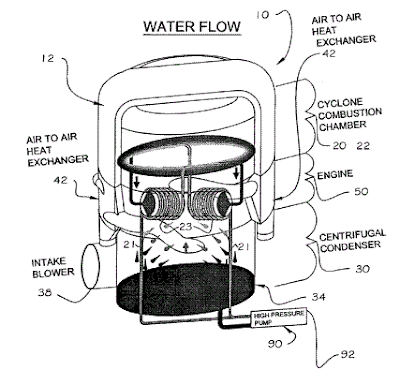New Hybrid Cycle Steam Engine Runs on Glycerol
 Here is more information on the Cyclone external combustion engine that is set to power ten 1-MW electric generators. I call it a "hybrid" cycle engine, because it has features belonging to Rankine, Carnot, Diesel, and Stirling cycle engines.
Here is more information on the Cyclone external combustion engine that is set to power ten 1-MW electric generators. I call it a "hybrid" cycle engine, because it has features belonging to Rankine, Carnot, Diesel, and Stirling cycle engines.The parties' plans are to power these industrial generators using a glycerol-based synthesis gas produced through Florida Syngas' proprietary plasma process called GlidArc™. Glycerol, the waste product of the bio-diesel industry, is a hydrogen rich, carbon neutral gas with its only waste products being hot water and useable heat. Under the agreement, Florida Syngas will design and build the synthesis gas converters, and Advent Power Systems will develop the engines and generator sets utilizing Cyclone's patented engine technology. Development of the equipment will be co-located in both Grant and Coconut Creek, Florida.___Source

The primary components of the engine include a condenser, steam generator and the requisite valves, cylinders, pistons, pushrods, main bearing, cams, and camshaft. Ambient air enters the engine through the intake blower, which circulates it through the condenser. According to Schoell, the flat-plate condenser �looks like a set of stacked record albums where air goes around the outside of the discs while the vapor on the inside is spun.� It is then directed through heat exchangers, and the air is pre-heated, enters the steam generator, and is mixed with atomized fuel that is also spun in the centrifuge.
...The power output is controlled by a rocker arm and cam design that opens and closes a needle valve in the head. This introduces high-pressure, high-temperature steam into the cylinder and provides the expansion force necessary to drive the pistons. Because it relies on the expansion of the fluid and not the expansive capacity of the fuel to create power, the Cyclone engine is fuel independent.___Autofieldguide

Whereas the old steam engine wasted most of its thermal energy (as much as 90%), the Cyclone Engine is highly efficient due to reheat and regeneration that recycle more than 30% of the heat generated from burning fuel. The engine operates at supercritical pressure (3,200 PSI) and temperature (1,100 degrees F) which makes the superheated steam behaves like a fluid rather than a gas so improving efficiency and making for a more compact engine. The overall thermodynamic efficiency is in the range of the Diesel engine (30-36%). The main advantages are: its capacity of using a wide range of fuels - gasoline, diesel oil, ethanol, kerosene, powdered coal, natural gas, etc.; continuous and complete combustion of fuel, creating less emissions than current gasoline or diesel powered internal combustion engines; high torque at start (700 ft/lb) which eliminates the need for a clutch and gearbox, simplifying the project and cutting down on power losses in transmission; the working fluid, water, is used to lubricate the engine, what avoids the long-standing problem of steam engines, the contamination of lubricating oil by water.___Wikipedia
Using glycerol-derived syngas for fuel is reasonable at this time, since glycerol is an inexpensive byproduct of biodiesel manufacture.
The Florida plans for 10 cyclone driven 1-MW generators, combined with the plasma syngas operation, demonstrates yet another "energy from garbage" approach. Forida appears to be in the vanguard of the advanced energy-from-garbage industry. That is unfortunate from the viewpoint of tourists who were hoping to see huge mountains of landfill dotting the Florida landscape in the near future. At this rate, Florida will be importing half the world's garbage before long--to use as fuel.
Cyclone Power Technologies
More Information on Cyclone engine operation
Labels: energy, energy from garbage, heat engines

0 Comments:
Post a Comment
“During times of universal deceit, telling the truth becomes a revolutionary act” _George Orwell
<< Home